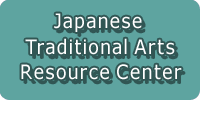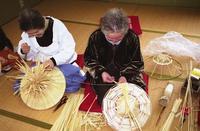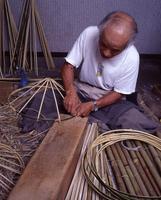

Total:35items

 |
|
 《Feature》
《Feature》Ecchu Fukuoka-Machi's Sedge Hat Making is referred to as the techniques in Fukuoka-machi town in Toyama Prefecture for producing sedge hats for outdoor activities including farmwork.
Ecchu Fukuoka-Machi's Sedge Hat Making is characterized by its effective gender division of labors: men's frame making by elaborately assembling thinly-sliced bamboo sticks into a cone shape and women's hat sewing by carefully sewing to the frame the sedge cultivated for hats. Its distinguished value as a cultural property lies in its entire process which is intensively organized in the local area from sedge cultivation through hat frame making, hat sewing, and finishing to shipping. Amazingly, all these processes are basically handcrafted, which has allowed the traditional sedge hat making techniques to be fully passed down for generations until today.
Inherited in an unchanged producing and handcrafting style over 400 years, the folk technology plays a significantly important role in historically studying crafting techniques of hats, particularly sewn hats in Japan.
According to the tradition, the sedge hat crafting in Fukuoka-machi started in Kakitsu Era in Muromachi Period (mid-15th century) and flourished in early Edo Period (early 17th century). The mid- to late Edo Period (18th -19th century) saw in Fukuoka-machi a row of independently-run sedge hat wholesalers and the establishment of a domain-run commercial organization called "sanbutsu-kaisho" dealing with local products. Accordingly, the town had come to function as a distributing or trading center of Tonami district in the prefecture.
Supported by the domain-wide industrial promotion, the sedge hat making bloomed at the end of Edo Period, marking a shipping record of 2.1 million hats in 1864. The locally crafted sedge hats, widely known as "Kaga-gasa", reportedly influenced sedge hat making sites dotting along the Japan Sea of the mainland. Fukuoka-machi remained a large production site of the hats with a shipping record of over a million hats until mid-1960s.
Today, the town's annual shipment has decreased to about 60,000, which still accounts for 90 per cent or more share of the domestic market. Its high-level crafting techniques making the best use of quality sedge has distinctly allowed the rich variety of hats produced and continued shipment of sedge hats boasting the highest quality across the country.
[Nationally designated as Important Intangible Folk Cultural Property]
Source: Cultural Properties Division, Takaoka Municipal Board of Education
Translation: Tomoko Yamamoto, reviewed by Marie Mine
| City/Town | Fukuoka-cho, Takaoka City, Toyama Prefecture |
|---|---|
| Location | Cultural Properties Division, Takaoka Municipal Board of Education
Tel: +81-(0)766-20-1453 (Japanese only) |
| Highlight/POI | You can touch the historical unchanged folk techniques. Top-quality sedge hats are the best for your souvenirs and good memories.
Assistance needed? For inquiries in English: JTCO Contact Form Your inquiries will be forwarded by JTCO in Japanese to the organization you wish to contact. |



